PONTIAC G8 2009 Manual Online
Manufacturer: PONTIAC, Model Year: 2009, Model line: G8, Model: PONTIAC G8 2009Pages: 356, PDF Size: 1.83 MB
Page 81 of 356
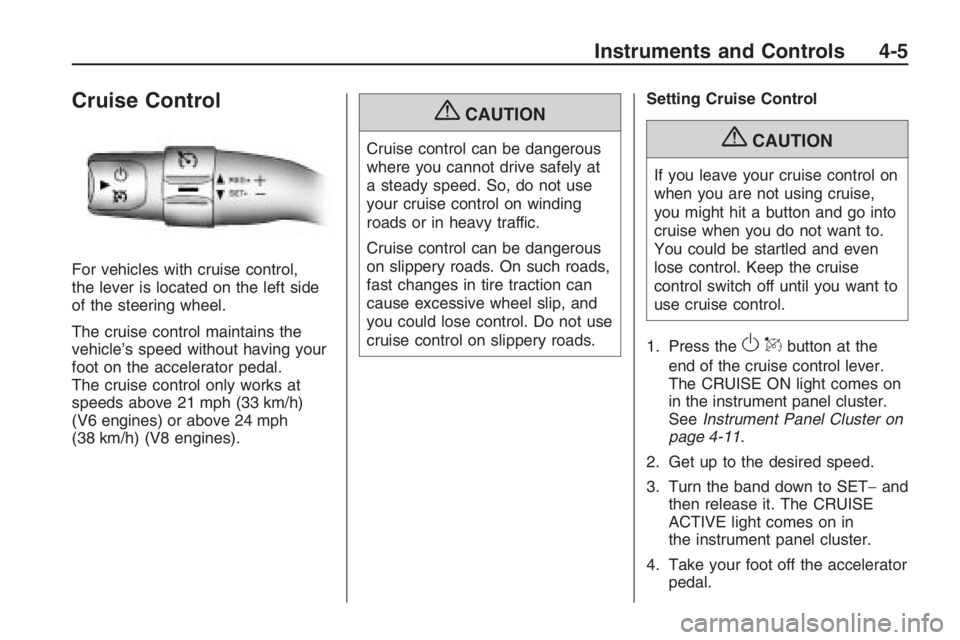
Cruise Control
For vehicles with cruise control,
the lever is located on the left side
of the steering wheel.
The cruise control maintains the
vehicle’s speed without having your
foot on the accelerator pedal.
The cruise control only works at
speeds above 21 mph (33 km/h)
(V6 engines) or above 24 mph
(38 km/h) (V8 engines).
{CAUTION
Cruise control can be dangerous
where you cannot drive safely at
a steady speed. So, do not use
your cruise control on winding
roads or in heavy traffic.
Cruise control can be dangerous
on slippery roads. On such roads,
fast changes in tire traction can
cause excessive wheel slip, and
you could lose control. Do not use
cruise control on slippery roads.Setting Cruise Control{CAUTION
If you leave your cruise control on
when you are not using cruise,
you might hit a button and go into
cruise when you do not want to.
You could be startled and even
lose control. Keep the cruise
control switch off until you want to
use cruise control.
1. Press the
OQbutton at the
end of the cruise control lever.
The CRUISE ON light comes on
in the instrument panel cluster.
SeeInstrument Panel Cluster on
page 4-11.
2. Get up to the desired speed.
3. Turn the band down to SET−and
then release it. The CRUISE
ACTIVE light comes on in
the instrument panel cluster.
4. Take your foot off the accelerator
pedal.
Instruments and Controls 4-5
Page 82 of 356
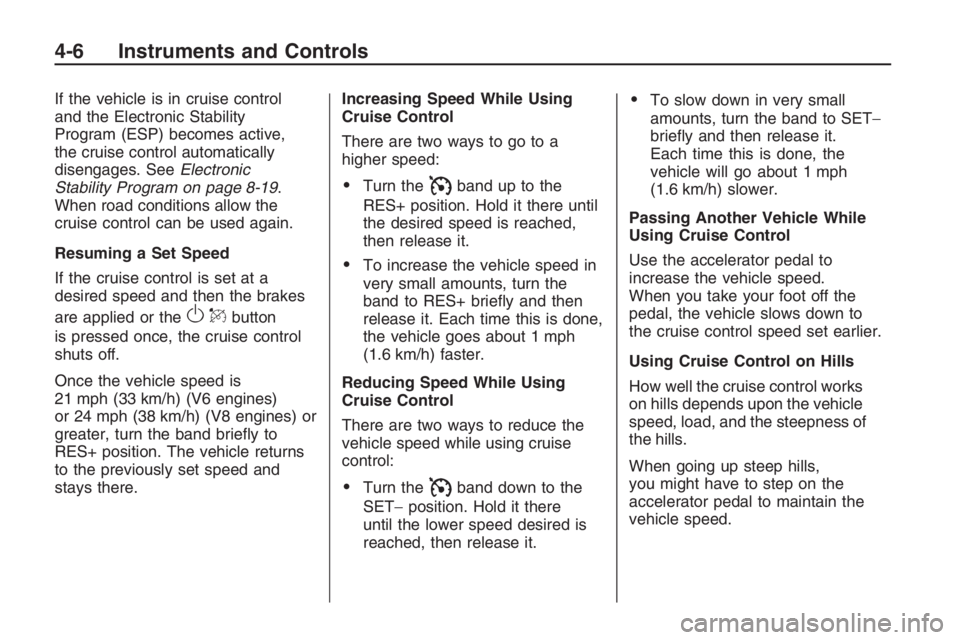
If the vehicle is in cruise control
and the Electronic Stability
Program (ESP) becomes active,
the cruise control automatically
disengages. SeeElectronic
Stability Program on page 8-19.
When road conditions allow the
cruise control can be used again.
Resuming a Set Speed
If the cruise control is set at a
desired speed and then the brakes
are applied or the
OQbutton
is pressed once, the cruise control
shuts off.
Once the vehicle speed is
21 mph (33 km/h) (V6 engines)
or 24 mph (38 km/h) (V8 engines) or
greater, turn the band brie�y to
RES+ position. The vehicle returns
to the previously set speed and
stays there.Increasing Speed While Using
Cruise Control
There are two ways to go to a
higher speed:
Turn theIband up to the
RES+ position. Hold it there until
the desired speed is reached,
then release it.
To increase the vehicle speed in
very small amounts, turn the
band to RES+ brie�y and then
release it. Each time this is done,
the vehicle goes about 1 mph
(1.6 km/h) faster.
Reducing Speed While Using
Cruise Control
There are two ways to reduce the
vehicle speed while using cruise
control:
Turn theIband down to the
SET−position. Hold it there
until the lower speed desired is
reached, then release it.
To slow down in very small
amounts, turn the band to SET−
brie�y and then release it.
Each time this is done, the
vehicle will go about 1 mph
(1.6 km/h) slower.
Passing Another Vehicle While
Using Cruise Control
Use the accelerator pedal to
increase the vehicle speed.
When you take your foot off the
pedal, the vehicle slows down to
the cruise control speed set earlier.
Using Cruise Control on Hills
How well the cruise control works
on hills depends upon the vehicle
speed, load, and the steepness of
the hills.
When going up steep hills,
you might have to step on the
accelerator pedal to maintain the
vehicle speed.
4-6 Instruments and Controls
Page 83 of 356
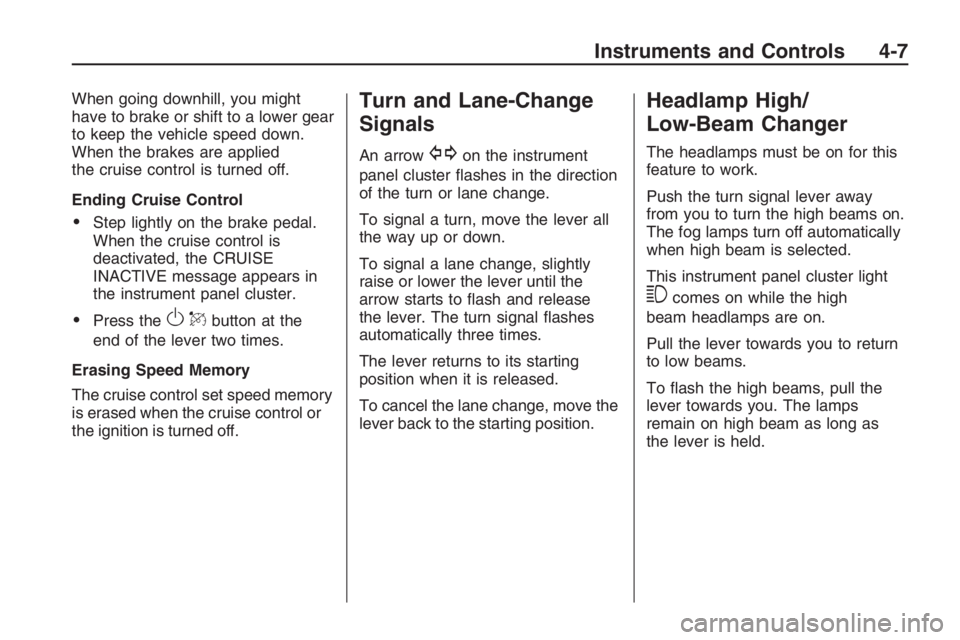
When going downhill, you might
have to brake or shift to a lower gear
to keep the vehicle speed down.
When the brakes are applied
the cruise control is turned off.
Ending Cruise Control
Step lightly on the brake pedal.
When the cruise control is
deactivated, the CRUISE
INACTIVE message appears in
the instrument panel cluster.
Press theOQbutton at the
end of the lever two times.
Erasing Speed Memory
The cruise control set speed memory
is erased when the cruise control or
the ignition is turned off.
Turn and Lane-Change
Signals
An arrowGon the instrument
panel cluster �ashes in the direction
of the turn or lane change.
To signal a turn, move the lever all
the way up or down.
To signal a lane change, slightly
raise or lower the lever until the
arrow starts to �ash and release
the lever. The turn signal �ashes
automatically three times.
The lever returns to its starting
position when it is released.
To cancel the lane change, move the
lever back to the starting position.
Headlamp High/
Low-Beam Changer
The headlamps must be on for this
feature to work.
Push the turn signal lever away
from you to turn the high beams on.
The fog lamps turn off automatically
when high beam is selected.
This instrument panel cluster light
3comes on while the high
beam headlamps are on.
Pull the lever towards you to return
to low beams.
To �ash the high beams, pull the
lever towards you. The lamps
remain on high beam as long as
the lever is held.
Instruments and Controls 4-7
Page 84 of 356
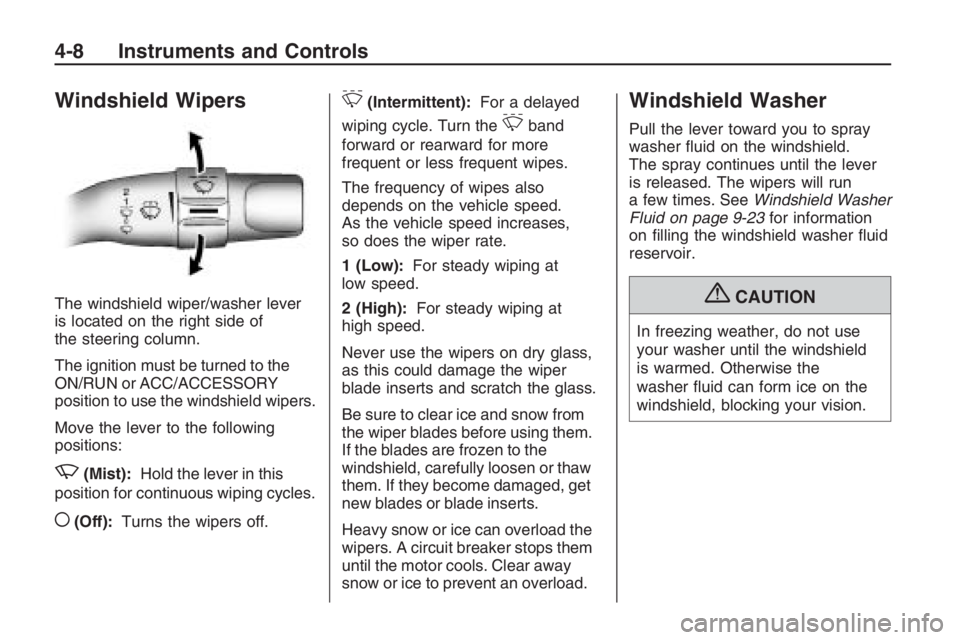
Windshield Wipers
The windshield wiper/washer lever
is located on the right side of
the steering column.
The ignition must be turned to the
ON/RUN or ACC/ACCESSORY
position to use the windshield wipers.
Move the lever to the following
positions:
z(Mist):Hold the lever in this
position for continuous wiping cycles.
((Off):Turns the wipers off.
&(Intermittent):For a delayed
wiping cycle. Turn the
&band
forward or rearward for more
frequent or less frequent wipes.
The frequency of wipes also
depends on the vehicle speed.
As the vehicle speed increases,
so does the wiper rate.
1 (Low):For steady wiping at
low speed.
2 (High):For steady wiping at
high speed.
Never use the wipers on dry glass,
as this could damage the wiper
blade inserts and scratch the glass.
Be sure to clear ice and snow from
the wiper blades before using them.
If the blades are frozen to the
windshield, carefully loosen or thaw
them. If they become damaged, get
new blades or blade inserts.
Heavy snow or ice can overload the
wipers. A circuit breaker stops them
until the motor cools. Clear away
snow or ice to prevent an overload.
Windshield Washer
Pull the lever toward you to spray
washer �uid on the windshield.
The spray continues until the lever
is released. The wipers will run
a few times. SeeWindshield Washer
Fluid on page 9-23for information
on �lling the windshield washer �uid
reservoir.
{CAUTION
In freezing weather, do not use
your washer until the windshield
is warmed. Otherwise the
washer �uid can form ice on the
windshield, blocking your vision.
4-8 Instruments and Controls
Page 85 of 356
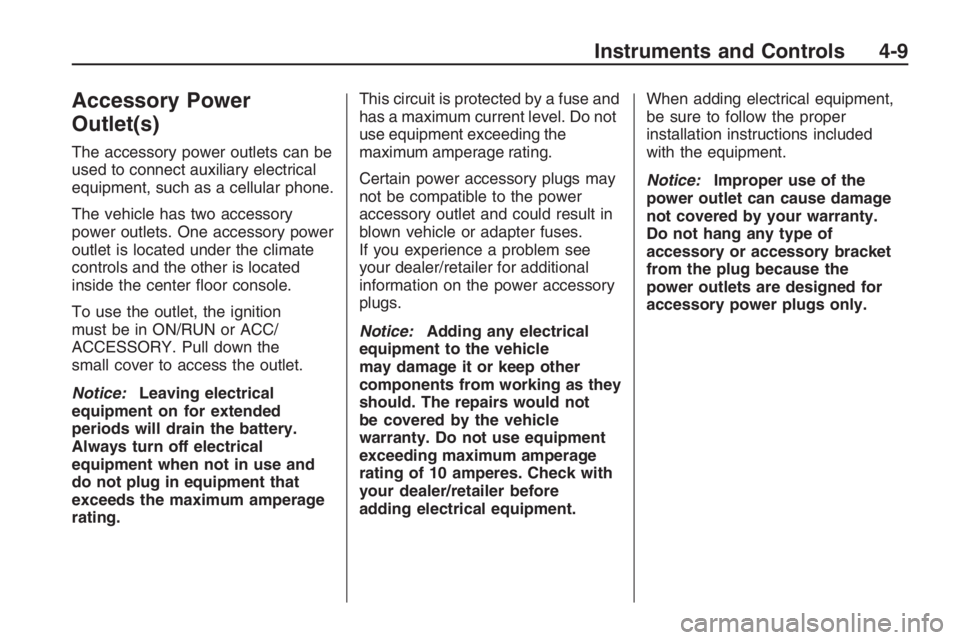
Accessory Power
Outlet(s)
The accessory power outlets can be
used to connect auxiliary electrical
equipment, such as a cellular phone.
The vehicle has two accessory
power outlets. One accessory power
outlet is located under the climate
controls and the other is located
inside the center �oor console.
To use the outlet, the ignition
must be in ON/RUN or ACC/
ACCESSORY. Pull down the
small cover to access the outlet.
Notice:Leaving electrical
equipment on for extended
periods will drain the battery.
Always turn off electrical
equipment when not in use and
do not plug in equipment that
exceeds the maximum amperage
rating.This circuit is protected by a fuse and
has a maximum current level. Do not
use equipment exceeding the
maximum amperage rating.
Certain power accessory plugs may
not be compatible to the power
accessory outlet and could result in
blown vehicle or adapter fuses.
If you experience a problem see
your dealer/retailer for additional
information on the power accessory
plugs.
Notice:Adding any electrical
equipment to the vehicle
may damage it or keep other
components from working as they
should. The repairs would not
be covered by the vehicle
warranty. Do not use equipment
exceeding maximum amperage
rating of 10 amperes. Check with
your dealer/retailer before
adding electrical equipment.When adding electrical equipment,
be sure to follow the proper
installation instructions included
with the equipment.
Notice:Improper use of the
power outlet can cause damage
not covered by your warranty.
Do not hang any type of
accessory or accessory bracket
from the plug because the
power outlets are designed for
accessory power plugs only.
Instruments and Controls 4-9
Page 86 of 356

Warning Lights,
Gages, and Indicators
Warning lights and gages can
signal that something is wrong
before it becomes serious enough
to cause an expensive repair or
replacement. Paying attention to
the warning lights and gages could
prevent injury.
Warning lights come on when
there may be or is a problem with
one of the vehicle’s functions.
Some warning lights come on brie�y
when the engine is started to indicate
they are working.Gages can indicate when there may
be or is a problem with one of the
vehicle’s functions. Often gages and
warning lights work together to
indicate a problem with the vehicle.
When one of the warning lights
comes on and stays on while driving,
or when one of the gages shows
there may be a problem, check the
section that explains what to do.
Follow this manual’s advice.
Waiting to do repairs can be costly
and even dangerous.
4-10 Instruments and Controls
Page 87 of 356

Instrument Panel Cluster
The instrument panel cluster is designed to let you know at a glance how your vehicle is running. You will know how
fast you are going, how much fuel you have, and many other things you will need to drive safely and economically.
Instruments and Controls 4-11
Page 88 of 356
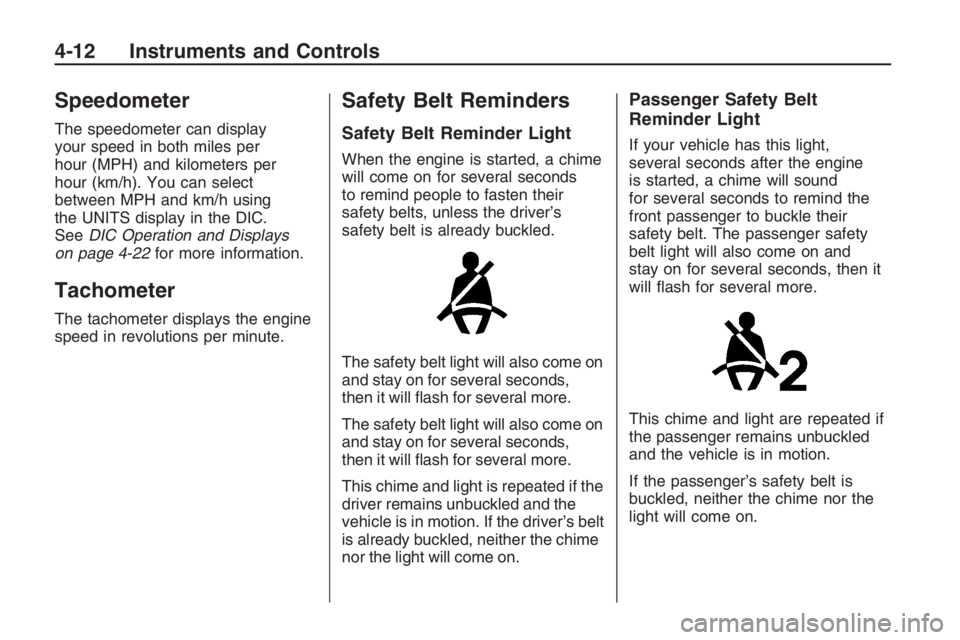
Speedometer
The speedometer can display
your speed in both miles per
hour (MPH) and kilometers per
hour (km/h). You can select
between MPH and km/h using
the UNITS display in the DIC.
SeeDIC Operation and Displays
on page 4-22for more information.
Tachometer
The tachometer displays the engine
speed in revolutions per minute.
Safety Belt Reminders
Safety Belt Reminder Light
When the engine is started, a chime
will come on for several seconds
to remind people to fasten their
safety belts, unless the driver’s
safety belt is already buckled.
The safety belt light will also come on
and stay on for several seconds,
then it will �ash for several more.
The safety belt light will also come on
and stay on for several seconds,
then it will �ash for several more.
This chime and light is repeated if the
driver remains unbuckled and the
vehicle is in motion. If the driver’s belt
is already buckled, neither the chime
nor the light will come on.
Passenger Safety Belt
Reminder Light
If your vehicle has this light,
several seconds after the engine
is started, a chime will sound
for several seconds to remind the
front passenger to buckle their
safety belt. The passenger safety
belt light will also come on and
stay on for several seconds, then it
will �ash for several more.
This chime and light are repeated if
the passenger remains unbuckled
and the vehicle is in motion.
If the passenger’s safety belt is
buckled, neither the chime nor the
light will come on.
4-12 Instruments and Controls
Page 89 of 356
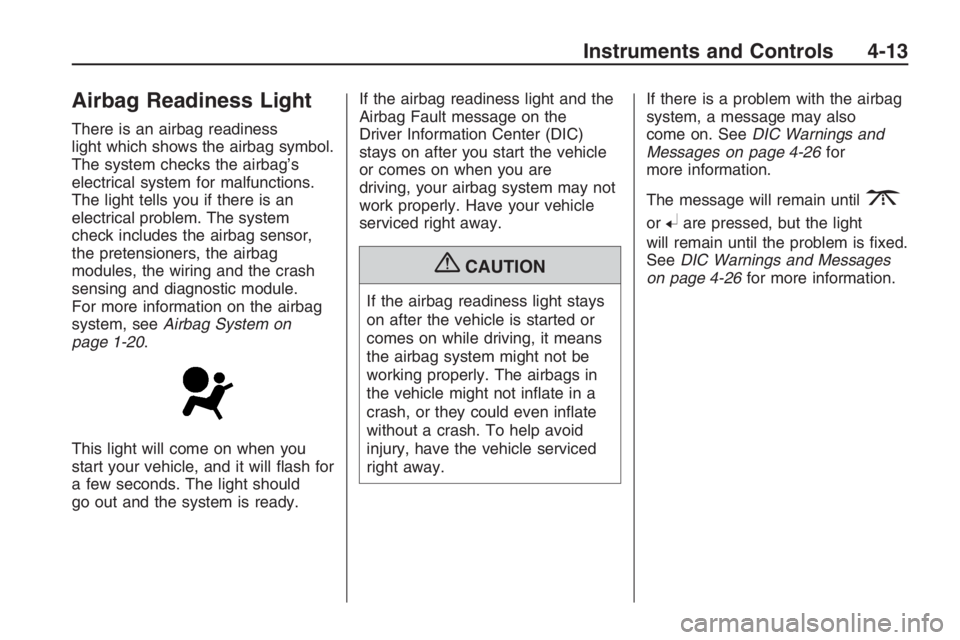
Airbag Readiness Light
There is an airbag readiness
light which shows the airbag symbol.
The system checks the airbag’s
electrical system for malfunctions.
The light tells you if there is an
electrical problem. The system
check includes the airbag sensor,
the pretensioners, the airbag
modules, the wiring and the crash
sensing and diagnostic module.
For more information on the airbag
system, seeAirbag System on
page 1-20.
This light will come on when you
start your vehicle, and it will �ash for
a few seconds. The light should
go out and the system is ready.If the airbag readiness light and the
Airbag Fault message on the
Driver Information Center (DIC)
stays on after you start the vehicle
or comes on when you are
driving, your airbag system may not
work properly. Have your vehicle
serviced right away.
{CAUTION
If the airbag readiness light stays
on after the vehicle is started or
comes on while driving, it means
the airbag system might not be
working properly. The airbags in
the vehicle might not in�ate in a
crash, or they could even in�ate
without a crash. To help avoid
injury, have the vehicle serviced
right away.If there is a problem with the airbag
system, a message may also
come on. SeeDIC Warnings and
Messages on page 4-26for
more information.
The message will remain until
3
or8are pressed, but the light
will remain until the problem is �xed.
SeeDIC Warnings and Messages
on page 4-26for more information.
Instruments and Controls 4-13
Page 90 of 356
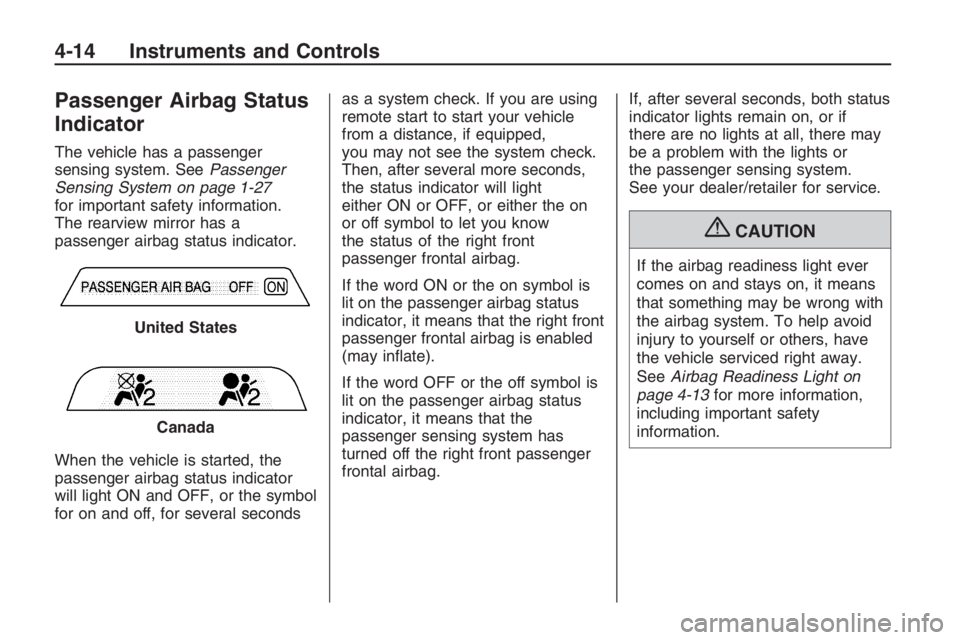
Passenger Airbag Status
Indicator
The vehicle has a passenger
sensing system. SeePassenger
Sensing System on page 1-27
for important safety information.
The rearview mirror has a
passenger airbag status indicator.
When the vehicle is started, the
passenger airbag status indicator
will light ON and OFF, or the symbol
for on and off, for several secondsas a system check. If you are using
remote start to start your vehicle
from a distance, if equipped,
you may not see the system check.
Then, after several more seconds,
the status indicator will light
either ON or OFF, or either the on
or off symbol to let you know
the status of the right front
passenger frontal airbag.
If the word ON or the on symbol is
lit on the passenger airbag status
indicator, it means that the right front
passenger frontal airbag is enabled
(may in�ate).
If the word OFF or the off symbol is
lit on the passenger airbag status
indicator, it means that the
passenger sensing system has
turned off the right front passenger
frontal airbag.If, after several seconds, both status
indicator lights remain on, or if
there are no lights at all, there may
be a problem with the lights or
the passenger sensing system.
See your dealer/retailer for service.
{CAUTION
If the airbag readiness light ever
comes on and stays on, it means
that something may be wrong with
the airbag system. To help avoid
injury to yourself or others, have
the vehicle serviced right away.
SeeAirbag Readiness Light on
page 4-13for more information,
including important safety
information. United States
Canada
4-14 Instruments and Controls